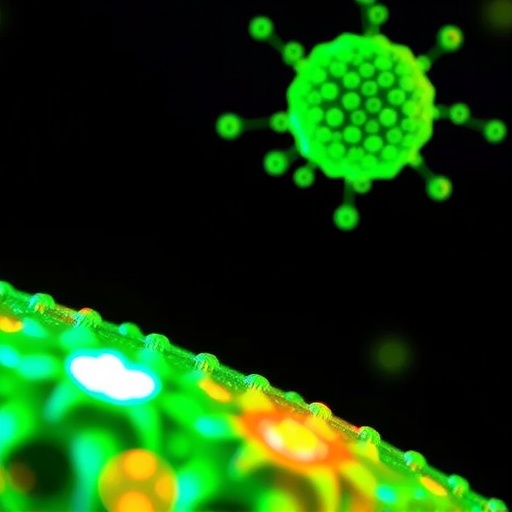In a groundbreaking study set to redefine the future of medical treatments, particularly in wound healing, researchers have turned their focus toward the innovative realms of piezoelectric nanomaterials. The research conducted by Chandra, Gupta, Goh, and collaborators examines the profound impact these materials can have on regenerative medicine. This study, strategically positioned at the intersection of nanotechnology and biomedicine, encapsulates the ethos of modern science—leveraging microscopic advancements to unlock macroscopic improvements in patient healing processes.
At the core of this investigation is the piezoelectric effect, where certain materials generate an electric charge in response to mechanical stress. This property can be harnessed to stimulate cellular activities, improve blood circulation, and enhance overall tissue regeneration. The implications of this phenomenon are significant, as traditional wound healing methods often grapple with various limitations, such as slow recovery times and inadequate responses to chronic conditions. The promising applications of piezoelectric materials lend themselves to an exciting new approach in healing therapies that could fortify the body’s natural repair mechanisms.
The research team meticulously developed piezoelectric nanomaterials tailored for medical applications. These nanomaterials are characterized by their small size and unique properties, rendering them ideal candidates for engaging with human cells at a cellular level. Unlike larger, more conventional materials, nanomaterials have the ability to penetrate biological barriers and effectively interact with cellular environments. This opens avenues for targeted treatments that can address specific cellular dysfunctions associated with wound healing, ultimately leading to faster and more effective recovery.
A particularly crucial aspect of the study involved testing these nanomaterials in various biological settings. The researchers prepared a series of in vitro experiments, which allowed them to meticulously observe how these materials perform in simulated bodily conditions. Their findings indicated that the application of piezoelectric nanomaterials resulted in a noticeable increase in cell proliferation and migration—two vital processes in wound healing. This aligns with the hypothesized mechanism that the induced electrical field from the materials may stimulate cellular functions crucial for tissue repair.
Moreover, this methodology also highlights the potential of piezoelectric nanomaterials in combating chronic wounds, which have long posed significant challenges within healthcare. By continuously stimulating the localized area of injury, these materials can potentially avert the complications that accompany slower healing processes. This could be especially beneficial for individuals suffering from diabetes or other conditions that impede healing, where standard treatments often fall short, leading to increased risk of infections and other complications.
An additional layer of the research focuses on integrating these nanomaterials within biodegradable scaffolds. The incorporation of piezoelectric nanomaterials not only aids in mechanical support during the healing process but also provides a sustainable approach to tissue engineering. Once the wound is sufficiently healed, these scaffolds can naturally degrade, thereby eliminating the need for surgical removal and reducing the risk of foreign body reactions in patients. Such advancements underscore a significant shift towards a more holistic and patient-centered approach in medical treatments.
The research underscores the versatility of piezoelectric nanomaterials beyond just wound healing. Their potential uses extend into various fields of regenerative medicine, including bone repair and nerve regeneration. By harnessing the piezoelectric properties, researchers are exploring how these materials can facilitate the repair of other types of tissues, thereby enhancing the scope of successful interventions in diverse medical contexts.
It is also pertinent to mention the safety profile of piezoelectric nanomaterials, as safety and biocompatibility remain paramount in the realm of biotechnology. The research team undertook a range of biocompatibility assessments to ensure that these materials do not invoke adverse immune responses. Their initial results have shown great promise, suggesting that these nanomaterials can coexist harmoniously within biological systems, which is crucial for their real-world application.
As the study moves into clinical trial phases, the implications of these findings could resonate far beyond the laboratory. The introduction of piezoelectric nanomaterials could catalyze a paradigm shift not only in wound care but also in the overarching framework of how we design and deploy therapeutic solutions across various health sectors. As researchers continue to unveil the potential of these novel materials, the vision of wearable technologies that assist in the healing process may soon transition from concept into practice.
Public engagement and discourse surrounding this research are vital. Given the broad implications for patient care and long-term health outcomes, it is critical for clinicians and patients alike to remain informed about emerging technologies that may alter traditional treatment pathways. The awareness of innovative therapeutic options can empower patients and physicians, fostering a collaborative environment in the pursuit of optimal healing strategies.
In the landscape of scientific research, fostering interdisciplinary collaboration will be paramount in advancing the application of piezoelectric nanomaterials. By bridging the gap between materials science, biology, and medicine, a new era of therapeutic modalities can be cultivated, where conventional methodologies are significantly enhanced through innovative material engineering.
As we stand on the cusp of what could be a profound leap in wound healing, the prospects for piezoelectric nanomaterials are not just limited to today’s innovations. The continuous research and the potential for future developments could lead to groundbreaking discoveries that might redefine how we approach healing and recovery in medicine. As such, the scientific community eagerly anticipates the next steps in this fascinating journey towards harnessing the power of the microscopic world for the betterment of human health and wellness.
Subject of Research: Piezoelectric nanomaterials and their impact on wound healing.
Article Title: Sonic Serenity: Piezoelectric Nanomaterials Reshaping Wound Healing Paradigms.
Article References:
Chandra, J., Gupta, G., Goh, K.W. et al. Sonic Serenity: Piezoelectric Nanomaterials Reshaping Wound Healing Paradigms. Ann Biomed Eng (2025). https://doi.org/10.1007/s10439-025-03909-6
Image Credits: AI Generated
DOI: https://doi.org/10.1007/s10439-025-03909-6
Keywords: Piezoelectric materials, wound healing, nanotechnology, regenerative medicine, biocompatibility.




